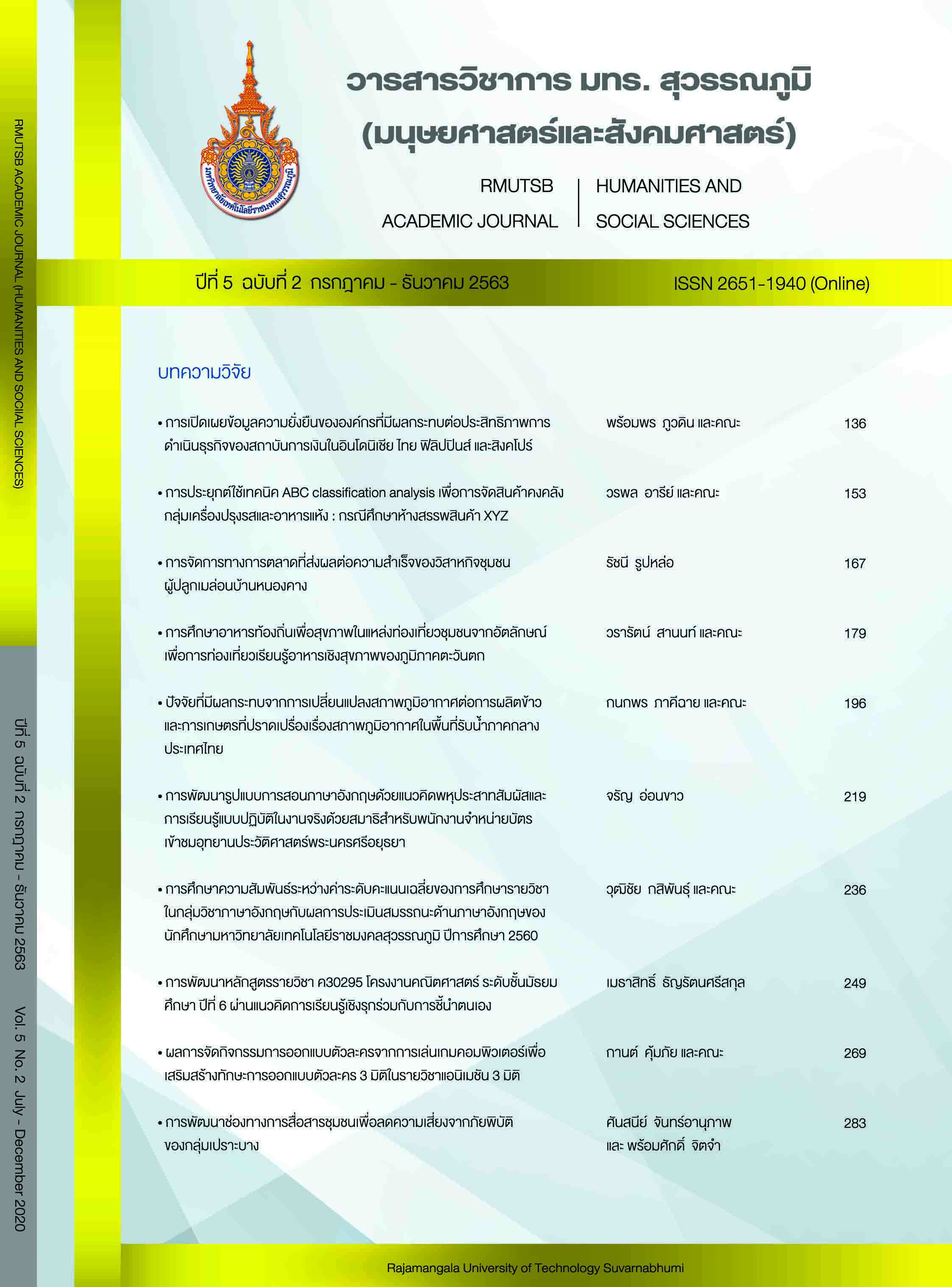The study of local healthy food from identity of community-based tourism for healthy food tourism destinations in western Thailand
Main Article Content
Abstract
This research aimed to study the local food context and sets of local healthy menu for creating stories and cooking lessons of local healthy food based on communities’ identity for tourists in western region. Quantitative methods with participatory action research was used in this study. There were 2 sample groups in this study selected by purposive sampling. Group one consisted of 25 community leaders, the elderly, local people and farmer and group two consisted of 14 local philosophers, entrepreneurs and housewives. The research instruments used in this research were questionnaire, in depth interview, and cooking demonstration. The quantitative data were analyzed using descriptive text. The results showed that local food resources such as native, natural or seasonal vegetable were used as ingredients in all 5 provincial communities. Those vegetables included of wood apple, Sand Ginger leave, bamboo shoot, sour cucumber, madan, oak fern, and bracken. Wild spices such as Szetchwan pepper or Sichuan pepper were also introduced. The home-grown vegetables used were herbal plants, such as galangal, lemongrass, kaffir lime leaf, holy basil, and wild ginger. Sour vegetables were also used. Fishes and chickens were main meat in the recipe, especially freshwater fishes which are available in natural water resources. Food resources were mostly non-chemicals. The cooking process used less cooking oil and fat. These showed the identity of healthy menu in each community. Regarding sets of local healthy menu for creating stories and cooking lessons of local healthy food for tourists, there were at least 6 sets of local healthy menu selected for creating stories and linking to stories and cooking lessons. Each set menu had 5 food groups. There were stories about food history, cooking methods, community lifestyle and nutritional properties. Thai cuisine was a wise wisdom and herbs were used as part of community tourism activities to support, and conserve wisdom in food resources and local food. It was also a channel to create jobs and generate income for the community leading to the upgrade of healthy food learning tourism.
Article Details
References
Anuntatanachai, R. (2005). Thai food: Balance food-herb. Bangkok: Sematum. (in Thai)
Anuntatanachai, R., Kittivarapon, T., Kulsetthalchalee, C., Onvimol, N., Khunsee, A., Charupan, K., Anantathanachai, N., Praprew, N., Panomwan, P., & Juntachote, T. (2010). Development of healthy Thai food set menus based on the sufficiency economy philosophy and community context. SDU Research Journal Sciences and Technology, 3(1), 59-74. (in Thai)
Fields, K. (2002). Demand for the gastronomy tourism product: motivational factors. In A. M. Hjalager, & G. Richards (Eds.), Tourism and gastronomy (pp. 36-50). London: Routledge.
Government Public Relation Department. (2012). The completion of hospitality tourism in ASEAN economic community. Retrieved 15 August 2017, from http://www.thai-aec.com/115#ixzz23gwp3FVz (in Thai)
Kim, Y. G., Eves, E., & Scarles, C. (2009). Building a model of local food consumption on trips and holidays: A grounded theory approach. International Journal of Hospitality Management, 28(3), 423-431.
Ministry of Tourism and Sports. (2011). Tourism and sports strategic plan 2012 – 2016. Retrieved 15 August 2017, from https://www.mots.go.th/ewt_dl_link.php?nid=7100 (in Thai)
National Statistical Office Thailand. (2012). Key statistics of Thailand 2012. Bangkok: Statistical Forecasting Bureau Nation Statistical Office. (in Thai)
Phumee, P., & Thomol, P. (2017). Biodiversity and utilizing benefit of wild food plants in Isan local markets: A case study in Huai Luang Basin area of northeastern Thailand. Mekong Chi Mun Art and Culture Journal, 3(1), 187-210. (in Thai)
Promkaew, P. (2007). Southern region cuisine. In 2nd International Conference on The celebrations on the auspicious occasion of His Majesty the King’s 80th birthday anniversary Thai food cultural diversity in globalization. Bangkok: Institute of Language, Art and Culture, Suan Dusit Rajabhat University. (in Thai)
Steward, J. H. (1953). Culture patterns of Puerto Rico. The Annals of the American Academy of Political and Social Science, 285, 95-103.
Trakoontivakorn, G. (2014). Thai tourism promotion through Image of northern culinary (research report). Bangkok: The Thailand Research Fund. (in Thai)
Wisootthipaet, S. (2014). Local food wisdom: Management for tourism in the eastern region, Thailand (Doctoral dissertation). Mahasarakham University, Mahasarakham. (in Thai)


